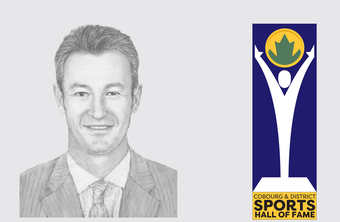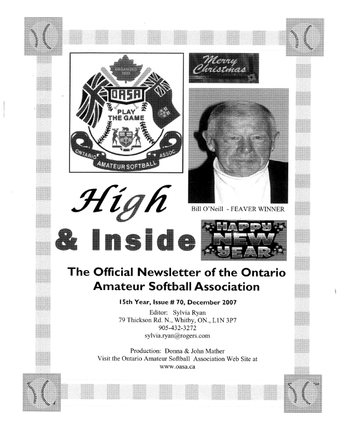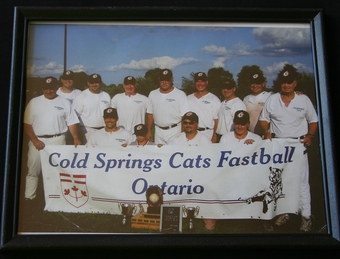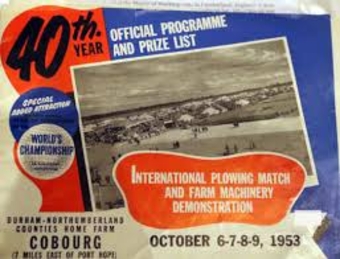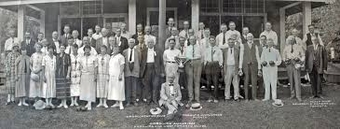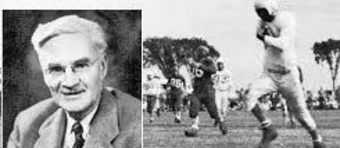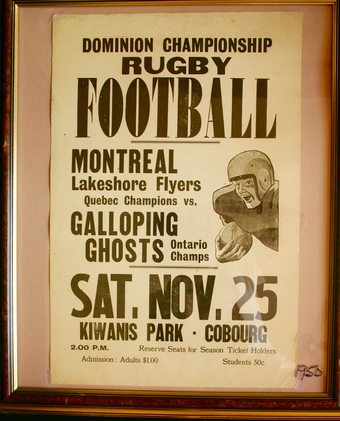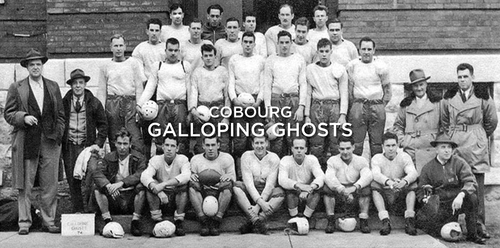By Ewart Timlin, Manager Edited by Donna Cole
2000
The Scarborough Blues won four straight games to capture the OASA Masters Elimination Tournament at Mitchell for the second consecutive year. The Blues and the runner-up Kitchener Waterloo Classics qualified to represent Ontario in the Eastern Canadian Masters competition in August of 2000.
The Cats won our opener 8-1 over Sudbury and then lost to Scarborough. We rebounded from the loss to win the next three straight: 8-0 over Cobourg, 9-5 over Sudbury again, and 4-1 over Mitchell. However, we were eliminated by K.W. Classics in the semi-final. Roger Cole, who hurled in all or part of the club's six matches, was named the Most Valuable Player in the tournament.
2001
Toronto McMurphys won all four of their starts to take the OASA Masters Elimination tournament in Mitchell this year. Nine teams took part and it marked the first time a Toronto team had won the event. In 2000, the title was taken by the Scarborough Blues, and the Cold Springs Cats won the championship the first three years the category was offered by the OASA.
In 2001, we finished third in the nine-team event with a 3-2 record. The Cats nipped Scarborough Blues 2-1 in the opener but then lost to Toronto before coming back to blank Mitchell Masters 5-0 and squeeze past the Blues again 5-4. Then we were eliminated by Oshawa in the semi-final.
Although we finished out of the money in Mitchell, Chris Calbury, Roger Cole and I decided to host the Eastern Canadian Masters Championship in Baltimore in September. After several telephone calls and meetings, we managed to engage two teams from out-of-province, namely Fredericton, N.B. and Calgary, Alberta. They joined the Ontario teams of Cobourg, Oshawa, Scarborough, Fingal, Toronto, and of course the host Cats. On a bright, warm weekend the Cold Springs team went undefeated in the competition as we won our three round robin matches 3-1 over Fredericton, 9-0 over Fingal, and 1-0 over Oshawa.
In the gold medal game against Oshawa in the seventh frame, Roger Cole fired a 1-2-3 punch to send the 1-1 tie into the eighth inning. In the bottom of the eighth, Bill Shannon laid down a perfect bunt single before advancing to second on a Stephen Mitts sacrifice bunt. Shannon then charged to third on a wild pitch. With only one out, Oshawa decided to walk the next two Cold Springs batters, loading the bases and hoping to force the Cats into a double play.
However, things didn't work out as planned. With two strikes against Ray Bickle and the bases loaded, another errant Oshawa pitch sent Shannon racing for home, but he never made it there. He was tripped and tagged out but the umpire called interference and the run counted, giving the Cats a 2-1 championship victory. Another dramatic finish! Besides winning the title on the field, the Cats helped to provide a good sum of money for the new Baltimore Arena as well.
2002
In 2002, the Stoney Creek Gators won six straight games to win their first OASA Masters Championship in a ten-team tournament at Ingersoll. Later in the summer, the Gators won the Eastern Canadian Masters Championship at Fredericton, N.B.! According to the tournament director Bruce Wills, the total number of teams dropped to four because the Ontario club was allowed 35-40 year olds and the Maritime teams had older players. Thus, two teams decided not to participate.
In the Ontario Championship this year, the Cats defeated Ingersoll and Mount Elgin. However, we were eliminated with two losses to Mitchell 6-2 and Stoney Creek 9-4.
2003
In the winter of2002-2003, Roger Cole and I decided that the Cats would probably fold because of the diminishing supply of appropriately-aged players in the area. Consequently, I helped Alec Rutherford with another Masters team, namely the Colborne Merchants. We worked along with Harry Jeschke, Legion Fields manager, to bring the OASA Masters Championship to Cobourg, where the Cold Springs club had hosted it in 1997.
Later in the spring, Roger made last minute phone calls to Gary Latchford and Mike O'Hearn to try to muster up players from the defunct Scarborough Blues team. Gary and Michael were successful in recruiting two valuable players - namely Mike Raccioppio and Mark Thompson - from the former Scarborough team. Also, another significant addition was Mike McCaw, whom Don Goodfellow recruited out of Belleville. Thus, along with the old stalwarts and new bodies, the Cats were rebuilt in 2003, and I was wearing two hats.
The Masters Championship schedule that materialized was composed of teams in three distinct divisions. In Division B, the Cats dominated by winning all three of their starts: 4-3 over Waterloo on a sixth inning home run by Mike McCaw and a four-hitter by Gary Vowles, 11-9 over Stoney Creek, and 15-0 over Fingal.
In quarter-final play, Cold Springs advanced with a 6-0 victory over Cobourg, behind Gary Vowles who gave up just four hits in recording the shutout. The Cats reached the final with a 5-2 decision over Stoney Creek, thanks to a grand slam in the fifth by Mike McCaw. Gary Vowles threw five innings for the win and held Stoney Creek runless.
The Cats seemed to "run out of gas" in the gold medal final against Oshawa. As I recalled in the 2001 Eastern Canadian Masters Championship game against the same team, we were victorious. This, perhaps, gave the Oshawa team the incentive to win the rematch in front of 350 fans at Legion Fields. The final outcome was a resounding win by Oshawa: 8-1.
Nevertheless, the Cold Springs club qualified, along with Oshawa, to play in the Eastern Canadian Championship at Truro, N.S. in September. In the Ontario tournament the Top Pitcher award was presented to Gary Vowles, who threw 21 innings with a 1.0209 ERA. Mike Raccioppio was the top hitter batting 9 for 18 at the plate.
Four Cats players from the silver medal winning squad - Mike McIvor, Ray Bickle, Mark Thompson, and Gary Latchford - did not travel east to the Maritimes that year. In their place we chose Ron Rosengren of Mississauga and Tim Chant of Cobourg, both members of the Colborne Merchants, as well as Cobourg Masters player Robbie Ellis, of Campbellford. I felt that these players would add the extra hitting depth to the club. We already had solid pitching with Roger Cole, Gary Vowles and Jim Oakman making the road trip east.
The Cold Springs Cats captured the bronze medal at the 2003 Eastern Canadian Masters Championship, held in Truro. We opened the tournament on Friday with a 1-0 setback against Durham, N.S.. However, Roger Cole pitched a gem and was named the Cats Most Valuable Player with a two-hitter.
On Saturday, the Cats rebounded with a 7-0 mercy victory over Glasgow, N.S.. Gary Vowles, with some fine hitting and pitching, was named the game's MVP. In game three, Cold Springs defeated Fredericton, N.B. 7-6. In the bottom of the seventh inning with two out and the game deadlocked at 6-6, Tim Chant cracked a homerun to give the Cats the win. Tim was named the game MVP while Jim Oakman and Gary Vowles combined for the win on the mound.
Cold Springs posted their third straight victory of the day, another 7-6 decision, over Calgary, Alberta in game four. With his fine fielding play and strong hitting, Chant earned the second MVP nod of the tournament. Vowles and Cole combined for the victory, Cold Springs' 3-1 record tied us for first in our pool with Minesing, Ontario and Calgary, Alberta. In the Cats first playoff game on Sunday, our bats were silenced when Calgary mercied us 7-0. Calgary went on to win the Eastern Canadian Championship, defeating Minesing 2-0 in the gold medal final. Thus, the Cats gained a third-place finish. Another highlight of the tournament was the hitting of a true Cats stalwart - Stephen Mitts. He finished the round robin play with an amazing .769 batting average.
On the East Coast we had an excellent time in rekindling old acquaintances. However, on the field our power hitters didn't come through in key situations, which accounted for our flat finish in the tournament.
2004
In 2004, after staging two fund-raising events with the great help of Bill Elliott, Barry Dawe, and Roger Cole the Cats planned to compete in at least 2 fastball tournaments. One was basically an intermediate tournament (The Jim Bradford Classic) held in Baltimore during June. The other was the Masters Eliminations (The Jack Cook Classic) held in Port Perry in July. The OASA elimination tournament in Port Perry is staged in honour of the late Jack Cook, who was an ardent worker in the OASA as a president, secretary and convenor.
I remember Jack distinctly one September in the mid 1990's after the Eastern Canadian Championship in his hometown, when he greeted me with the usual "old farmer" salutation. Then we discussed the current status of the softball world, after which Jack walked to Diamond One, where he succumbed to a major heart attack. What a tragic ending for such a fine person.
At the Masters level, especially, a manager requires a great deal of help in enlisting players from year to year. In this regard, I discovered that Mike McCaw and Mike O'Hearn fit the bill to a "T". The former was responsible for recruiting a fine fielding catcher - Darren Crouter, and the latter a fleet footed outfielder, Steve Mo.
We entered the Jim Bradford Classic with two basic goals in mid-June. One was to practice together as a team and the second was to have fun while participating.
Consequently, we achieved both goals in Baltimore. On Friday, we started the tournament slowly as Cobourg Stingers humbled us 11-3. But then we roared back on Saturday with wins over Peterborough Juniors 8-1 and Stittsville 7-3. This placed us in the playoffs against Belleville on Sunday, when unfortunately, because of base running miscues in the early frames, we didn't score a run and were defeated 3-0.
Our second tournament occurred in Port Perry where we began the Masters Eliminations on Friday with a convincing victory 9-2 over Cloyne (comprised mainly of former fastball superstars). On Saturday we suffered our first loss at the hands of Kitchener-Waterloo (4-3) and a major setback to our long-time pitching ace Roger Cole when he severely injured his arm. Later that same day, the Cats clobbered Chepstow (8-2).
In the preliminary round, because of our wins and our hefty plus, minus aggregate we gained a first-place finish in our division. This standing meant we crossed over Sunday to meet our long-standing rivals, Oshawa in our first playoff game. We gained some revenge for the 2003 loss to Winchester-Arms in the final by defeating Oshawa 5-1. Later that morning we were defeated by Colborne 3-1 which placed us in the bronze medal game with Stoney Creek. Luckily, in the 7th inning we scrambled back to beat the Gators 3-1 and gain a 3rd place finish in the 15 team elimination tournament. In the tournament Gary Vowles came to the forefront and pitched stupendously during 5 and ½ games.
At the time of this writing, the Cats are preparing to attend the World Senior Fastball Tournament in North Bay on Labour Day Weekend. In one regard, it has been a disastrous summer of '04 in the fact that because of a serious arm injury, Roger Cole has been forced to hang up his pitching shoes after a long and illustrious career. I've told Roger, on a few occasions that when he retires from pitching, I'll retire from managing. This is perhaps, the cue to disappear from the fastball scene. However, that World's Masters Tournament in Edmonton in 2005 sounds very appealing. Well! That belongs to another chapter in a future book. Perhaps .... maybe .... I'll think about it.
During the last 30 years, I was fortunate enough to have been surrounded by several great ball players. This has resulted in winning 7 Ontarios, 2 Canadians, 1 Eastern Canadian, 1 Finalist, and at least 2 third place finishes. However, as I have stated before winning laurels is only one aspect of participating in this great game of fastball.
Another very important aspect is making and rebuilding friendships. In competing against eight provinces and territories, and US teams from states such as Ohio and New York, I have acquired relationships that will certainly last a lifetime.
My sincere appreciation is extended to Shannon Cole and Donna Cole for proofreading and transcribing my ramblings. Also, a great deal of thanks goes to the following people, publications, and facilities for providing reference material: Layton Dodge, Peter Handley, Darryl Thompson, Bonnie Timlin, Ray Bickle, Cobourg Star, "High and Inside", New Brunswick Telegraph and Journal, Softball Ontario News, and the Gordon King Centre.
Cold Springs Cats - Players and Management "Through The Years"
Rick Ainsworth Rob Ellis Stan McKnight
Maurice Alderson Gary Ferguson Craig Minifie
Roger Alexander Ivan Ferguson Steve Mitts
Brian Beatty Wayne Ferguson Steve Mo
Phil Beatty Neil Francis Howie Mouncey
Dave Bemma Murray Garrick Steve Neeley
Ray Bickle Mike Gibson Tim Neron
Don Goodfellow Bernie Nicholls
Perry Bowles Paul Goodfellow Jim Oakman
Terry Bowles Craig Gray Dave O'Connell
Jim Bradford Rob Hardy Mike O'Hearn
Les Brill Dave Hare Gord Oosterhoff
Don Burkitt Kent Harper Rick Palmateer
Jim Burkitt Paul Hasson Mike Raccippio
Allan Burnham Dave Hedger Ed Ristan
Eric Buttars
Bill Buys Ron Herriot Bill Rollings
Chris Calbury Rob Hook Pat Rutherford
Bill Campbell Gary Hope Dave Ruthowsky
Doug Campbell Mike Irwin Bill Ryan
Bill Cane Terry Irwin Frank Schram
John Cane Lorne Jamieson Bill Shannon
Peter Cane Rick Jaynes Phil Solomon
Bill Carrigan Marty Kernaghan Randy Sughrue
Tim Chant Pete Landers Lynn Thackeray
Jim Chase Larry Landry Mark Thompson
Rick Clark Harold Lang Ewart Timlin
Roger Cole Scott Lang Greg Timlin
Brian Condon Gary Latchford Jeff Timlin
Mike Connolley Terry Lewis Ross Timlin
Chris Cook Stu Little Dave Tinney
Darren Crouter Don MacDonald Steve Virag
Phil Crouter Bryan Madge Gary Vowles
Andy Dalgarno Todd March Roger Wakeman
Barry Dawe Paul Marineau Dave Waldie
Brain Dolley John Maughan Scott Wasson
Dan Donahue Mike May Joe Watters
Rob Doncaster Mike McCaw Wayne Wells
Terry Elinsky Roger Mcintosh Kevin Woodward
Bill Elliott Mike McIvor
Don Elliott
Reviewed August 2020
